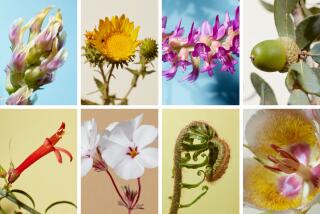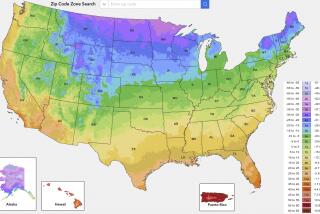SCIENCE : Greenhouse Gives Botanists Fresh View of Plant Life : Smithsonian Institution’s new $1-million botanical laboratory will allow scientists to study rare and endangered species.
- Share via
WASHINGTON — Somewhere hidden among the shelves of greenery, lingering in one of the five climate-controlled rooms, may be a plant containing secrets for fighting human disease. Threads of species once feared extinct now bloom under the clear roof. Botanists who for years studied only dried specimens now examine live plants.
Scientists at the Smithsonian Institution’s Museum of Natural History are rejoicing over a new $1-million greenhouse in Suitland, Md., that will enable them not only to study live plants from all over the world, but also play a part in conserving them.
“On a planet where resources are constantly shrinking and population is growing, understanding our resources becomes more crucial,” Warren Wagner, a Smithsonian botanist, said.
The greenhouse at the Smithsonian’s second campus, a half an hour’s drive from the main campus on the National Mall, closes a void that Museum of Natural History botanists have been pining to fill since the museum began housing live specimens in 1978.
Until the 6,000-square-foot facility opened, scientists were forced to make do with a relatively tiny makeshift greenhouse in the attic of the Mall’s museum building.
Smithsonian botanist John Kress said the greenhouse, a high-tech child of the Computer Age, allows the government to bring plants--some rare and endangered--to a controlled setting to identify and experiment with them, and ensure those threatened species a chance for survival.
“Before, we just collected, dried and stored them for study,” said Kress, an expert in Heliconia plants--which are known for their fluorescent, stiff flowers. “Now, we can grow for conservation, which will benefit science, commercial industries and medicine.”
Conservation is especially critical for some plants in Hawaii and South America, among other places. Wagner said some species have been brought to the brink of extinction by fires, logging, road construction and the choking growth of plants brought in from other parts of the world.
He said the goal of Smithsonian botanists is to travel the world looking for exotic indigenous plants to bring back to poke, probe and read DNA from in hopes of finding the right conditions for plants to grow.
“You can’t carry on experiments in the pouring rain in Madagascar or Brazil,” Wagner explained amid the artificial mist of the “tall room,” where larger tropical plants can climb higher than a giraffe.
Kress held a small, ordinary-looking tropical plant in one hand, giving special admiration to its shock of not-yet-flowered greenery. He liberated the plant in 1992 from an oil pipeline area trampled by guerrillas in Colombia.
“There are no other collections of this plant in the world,” Kress said of the Heliconia estherae , a plant with yellow or red fluorescent banana-like flowers that hang down.
Heliconia is a flowering plant with some varieties that can be found in Southern California. One variety is the bird of paradise, well-known for its colorful, bird-like appearance.
Wagner, whose specialty is Hawaiian plants, recently worked with a husband-and-wife team of UC Irvine botanists, Ann Sakai and Stephen Weller, to study Schiedea , a genus of shrubs and vines that are in the carnation family . The genus has an unusual trait--it contains both bisexual and asexual plants.
About a third of the 25 species of Schiedea are on the federal endangered species list. Smithsonian botanists are hoping they will be able to save those species by determining the best growing conditions for the plants.
Schiedea adamantis , one of the specimens grown in the greenhouse, is only found on Diamond Head Crater, within the city limits of Honolulu. It’s so rare that it doesn’t even have a common name. Sakai wrote a recovery plan in February for the U.S. Fish and Wildlife Service to save the threatened plant.
Finding endangered species of plants can be hard work. Sakai and Weller said that because of grazing on the Hawaiian Islands, goats and pigs tend to eat many species of plants that might otherwise survive. So, to find Schiedea attenuata , a small shrub, two plant collectors from the National Tropical Botanical Garden had to use ropes to swing down the side of a cliff to find the untouched specimens.
The Smithsonian greenhouse will not be open to the public. However, scientists all over the country will likely receive specimens from the new facility, and some of them will appear in public greenhouses, Kress said.
The Smithsonian greenhouse is equipped with temperature-control devices designed to counteract Washington’s especially hot summers and cold winters. In one room, a dry climate houses plants from such areas as Costa Rica and Peru. Another room across the center hallway emits a thick mist in a much cooler setting, playing host to day flowers from Africa and South America.






